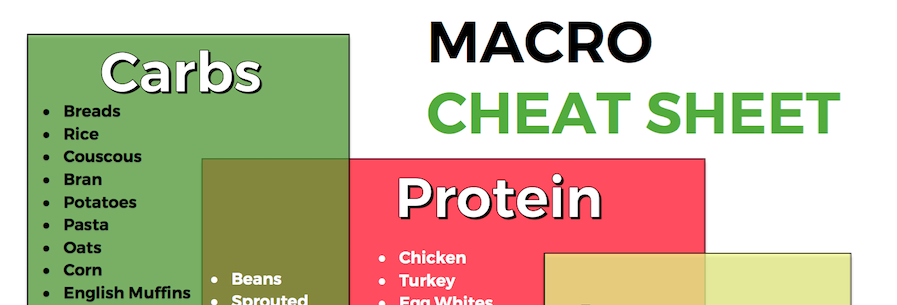Calorie is king right…? Well, yes and no.
Regardless of your goal understanding energy balance is key. Negative energy balance (burning more energy/calories than you consume) will facilitate weight loss, while a positive energy balance (burning less energy/calories than you consume) will promote weight gain.
However, it is the breakdown of those calories that is just as, if not more, important!
By tracking the breakdown of calories into the three main macronutrients, we can ensure that we are providing our bodies with optimal food sources for optimal performance. “Macros” are the three dietary elements that make up our food: proteins, fats, and carbohydrates. All foods contain one, two or all of these macronutrients, and they each have a significant and unique effect on our bodies and metabolism.
Just because two different food items have the caloric value, that doesn’t necessarily mean that they macronutrient breakdown is going to be the same. Something like broccoli is going to have a vastly different nutrient profile than that of something like a bag of Doritos.
Further below, you will find that I have put together a Macro Cheat Sheet that will help you determine which foods belong to which macronutrients. You can download and print out this cheat sheet for later reference.
Protein
The body’s “building blocks.” Used to build and maintain muscle and lean tissue, facilitate other important bodily functions.
How Much?
The amount of protein needed will vary from person to person. A low range would be about .5 grams per day per pound of bodyweight (so for a 100 pound person, 50 grams a day minimum.) I usually recommend anywhere from .75 grams to 1.5 grams per pound depending on age, bodyweight, physical activity and goals.
Fat
The most energy-dense source of fuel for the body. Fats can be stored for energy, leading to the accumulation of adipose tissue (body fat.) Essential for many functions within the body.
How Much?
Again, this macronutrient is typically based on body weight and individual goals which means that amount of recommended dietary fat will vary… A range 20 – 30% is what you will typically find. A simple rule for fat intake is to consume half your body weight in pounds (or roughly your entire body weight in kg) in grams of fat. Example: 150 lb = 75 grams of fat.
Carbs
The body’s most readily available energy source. Also can be stored for energy in adipose tissue as body fat. Provide much of the all-important fiber in our diet.
How Much?
After you have calculated the amount of protein and fat requirements, the remaining amount of calories should be allocated to carbs. This will generally be some where in the range of 1.5 – 2.0 grams of carbs per pound of body weight.
It is important to point out that minimum amounts of fiber intake should also be considered. 25 grams/day is the minimum. Though 35 grams/day for women and 48 grams/day for men is considered optimal.
Bottom Line
Understanding the different macronutrients can be confusing but the bottom line is this: optimal health and weight loss can only be achieved with a proper balance of each, and a calorie to a calorie is not necessarily equal.
Once you can easily identify which macro group a food falls into, you can use that information to build healthy, balanced meals that will fuel your body for optimal health and performance. Just remember, your body’s needs are very unique and what works for one person won’t necessarily work for someone else.
Need Something Custom?
The information above are some general guidelines for determining the amount of protein, fat and carbohydrates your body needs on a daily basis. However, if you are looking for something more specific to YOUR BODY, I can create a Custom Meal Plan that will provide you and exact breakdown of each macronutrient.
If you are ready to start losing weight or adding lean muscle mass on a consistent basis…enjoy the foods you are eating at every meal, throughout the week…then you should definitely check out this page.
I Want A Custom Meal Plan!
A Macro Cheat Sheet
At this point, you might be asking yourself; “How do I know which foods belong to which macronutrient?“
I have answer to that question!
I have created a Macro Cheat Sheet that you can download and print out for quick reference. As you progress with your nutritional habits, this cheat sheet will likely become unnecessary to you, but it is a great starting point to ensure you have things covered.
You can download the Macronutrient Cheat Sheet using the form below. Just enter your name and email address and you’ll have instant access to download this list.
Need a Coach?
If you need to find someone that will hold you accountable, answer your questions, help you, and PUSH YOU for the entire duration of your workout! Luckily for you, that’s what me and my team are here for. If you don’t have a coach yet and want one, I’d love to be your coach and help you through a fitness program. I am available to help you reach your goals!

Email Me: coachchris@yourfitnesspath.com
Connect on Facebook: fb.com/coachcoburn
YouTube: https://youtu.be/coachchriscoburn
Instagram: @chris_coburn
Twitter: @yourfitnesspath



0 Comments